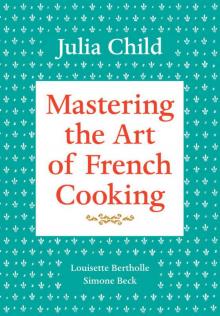- Home
- Julia Child
Mastering the Art of French Cooking, Volume 1 Page 25
Mastering the Art of French Cooking, Volume 1 Read online
Page 25
Filets de Sole Farcis
[Stuffed Fish Filets]
Make 1 cup of the fish quenelle mixture. Mix into it ¼ cup of finely diced mushroom duxelles, and 2 to 3 tablespoons additional whipping cream. Place a spoonful in the center of each seasoned, raw filet, and fold or roll the filet to enclose the filling. Tie with white string. Poach, garnish, and sauce the filets following any of the preceding suggestions.
COQUILLES ST. JACQUES À LA PARISIENNE
[Scallops and Mushrooms in White Wine Sauce]
Exactly the same sauce parisienne as that for the poached fish filets in the preceding recipes is delicious with scallops gratinéed in their shells. This dish may be prepared ahead, and gratinéed just before serving. A fine, chilled white Burgundy or a very good white Graves would go well with it. Scallops are usually served as a first course, or as a light luncheon dish.
For 6 scallop shells
Cooking the scallops
1 cup dry white wine or ¾ cup dry white vermouth
½ tsp salt
Pinch of pepper
½ bay leaf
2 Tb minced shallots or green onions
A 2-quart enameled or stainless steel saucepan
Simmer the wine and flavorings for 5 minutes.
1 lb. washed scallops
½ lb. sliced fresh mushrooms
Add the scallops and mushrooms to the wine, and pour in enough water barely to cover ingredients. Bring to the simmer. Cover, and simmer slowly for 5 minutes. Remove scallops and mushrooms with a slotted spoon, and set aside in a bowl.
The sauce
Rapidly boil down the cooking liquid until it has reduced to 1 cup.
A 2-quart enameled or stainless steel saucepan
3 Tb butter
4 Tb flour
¾ cup milk
2 egg yolks
½ cup whipping cream, more if needed
Salt and pepper
Drops of lemon juice
Following the directions in sauce parisienne, cook the butter and flour slowly together for 2 minutes. Off heat, blend in the boiling cooking liquid, then the milk. Boil 1 minute. Blend the egg yolks and cream in a bowl, then beat the hot sauce into them by driblets. Return the sauce to the pan and boil, stirring, for 1 minute. Thin out with more cream if necessary. Season to taste with salt, pepper, and lemon juice. Strain.
6 scallop shells or pyrex or porcelain shells of ⅓ cup capacity
Cut the scallops into crosswise pieces about ⅛ inch thick.
½ Tb butter
6 Tb grated Swiss cheese
1½ Tb butter cut into 6 pieces
Blend two thirds of the sauce with the scallops and mushrooms. Butter the shells. Spoon the scallops and mushrooms into them, and cover with the rest of the sauce. Sprinkle with cheese and dot with butter. Arrange the shells on a broiling pan.
(*) Set aside or refrigerate until ready to gratiné.
Fifteen minutes before serving, set the scallops 8 to 9 inches under a moderately hot broiler to heat through gradually, and to brown the top of the sauce. Serve as soon as possible.
TWO RECIPES FROM PROVENCE
COQUILLES ST. JACQUES À LA PROVENÇALE
[Scallops Gratinéed with Wine, Garlic, and Herbs]
This good recipe may be prepared in advance and gratinéed just before serving. The following proportions are sufficient for a first course. Double them for a main course. Serve a chilled rosé, or a dry white wine such as côtes de Provence.
For 6 scallop shells
⅓ cup minced yellow onions
1 Tb butter
1½ Tb minced shallot or green onions
1 clove minced garlic
Cook the onions slowly in butter in a small saucepan for 5 minutes or so, until tender and translucent but not browned. Stir in the shallots or onions, and garlic, and cook slowly for 1 minute more. Set aside.
1½ lbs. washed scallops
Salt and pepper
1 cup sifted flour in a dish
Dry the scallops and cut into slices ¼ inch thick. Just before cooking, sprinkle with salt and pepper, roll in flour, and shake off excess flour.
2 Tb butter
1 Tb olive oil
A 10-inch enameled skillet
Sauté the scallops quickly in very hot butter and oil for 2 minutes to brown them lightly.
⅔ cup dry white wine, or ½ cup dry white vermouth and 3 Tb water
½ bay leaf
⅛ tsp thyme
Pour the wine, or the vermouth and water, into the skillet with the scallops. Add the herbs and the cooked onion mixture. Cover the skillet and simmer for 5 minutes. Then uncover, and if necessary boil down the sauce rapidly for a minute until it is lightly thickened. Correct seasoning, and discard bay leaf.
6 buttered scallop shells, or porcelain or pyrex shells, of ⅓ cup capacity
¼ cup grated Swiss cheese
2 Tb butter cut into 6 pieces
Spoon the scallops and sauce into the shells. Sprinkle with cheese and dot with butter.
(*) Set aside or refrigerate until ready to gratiné.
Just before serving, run under a moderately hot broiler for 3 to 4 minutes to heat through, and to brown the cheese lightly.
THON À LA PROVENÇALE
[Tuna or Swordfish Steaks with Wine, Tomatoes, and Herbs]
Tomatoes, wine, herbs, and garlic are a good contrast to tuna or swordfish, and this dish can be served either hot or cold. Boiled potatoes and green beans would go well, and a chilled rosé wine, or a dry white such as côtes de Provence, or Riesling.
For 6 to 8 people
3 lbs. fresh tuna or sword-fish cut into steaks ¾ inch thick (if fish is frozen, thaw it)
A 9- by 14- inch pyrex baking dish about 2½ inches deep
1 tsp salt
2 Tb lemon juice
6 Tb olive oil
⅛ tsp pepper
Remove skin, and cut fish steaks into serving pieces. Blend salt and lemon juice in baking dish, then beat in the oil and pepper. Arrange the fish in the dish, and baste with the marinade. Cover with waxed paper and marinate 1½ to 2 hours, turning and basting the fish with the marinade several times. Drain the fish and dry it thoroughly on paper towels. Discard the marinade, which will be strong and fishy.
3 to 4 Tb olive oil, more if needed
A skillet
Sauté the fish rapidly in very hot olive oil for a minute or two on each side to brown lightly. Rearrange the fish in the baking dish.
Preheat oven to 350 degrees.
1 cup minced yellow onions
3 lbs. fresh, ripe, red tomatoes peeled, seeded, juiced, and chopped
2 cloves mashed garlic
½ tsp oregano
¼ tsp thyme
¼ tsp salt
⅛ tsp pepper
Cook the onions slowly in the skillet for 5 minutes or so until tender but not browned. Stir in the tomato pulp, garlic, seasonings, and herbs. Cover skillet and cook slowly for 5 minutes. Correct seasoning, and spread the tomato mixture over the fish.
1 cup dry white wine or ⅔ cup dry white vermouth
Place a cover or aluminum foil over the baking dish and bring to the simmer on top of the stove. Then set in lower third of preheated oven and bake for 15 minutes. Pour in the wine and bake for 30 minutes more, turning oven down to 325 degrees as soon as fish is simmering.
A serving platter
Remove fish to a serving platter, scraping the sauce off the fish and back into the baking dish. Keep fish warm for about 5 minutes while finishing the sauce.
1 to 2 Tb tomato paste for added flavor and color
Optional: 1 Tb meat glaze, page no, for depth of flavor
Boil down the sauce over high heat until it has reduced to about 2 cups. Stir in the tomato paste and optional meat glaze. Simmer for a moment, and correct seasoning.
1 Tb flour blended to a paste with 1 Tb softened butter
2 to 3 Tb chopped parsley
Off heat, beat in the flour and butter paste
, and bring again to the simmer for 1 minute. Stir in the chopped parsley, spoon the sauce over the fish, and serve.
(*) Fish may be set aside, then covered and reheated in the oven, but be careful not to overcook it.
Other Fish—Green cod or coalfish, ocean pollack, and halibut may be cooked in the same way. They need no marinating and require only 20 to 30 minutes of baking.
TWO FAMOUS LOBSTER DISHES
A NOTE ON DEALING WITH LIVE LOBSTERS
If you object to steaming or splitting a live lobster, it may be killed almost instantly just before cooking if you plunge the point of a knife into the head between the eyes, or sever the spinal cord by making a small incision in the back of the shell at the juncture of the chest and the tail.
HOMARD THERMIDOR
[Lobster Thermidor-Gratinéed in its Shell]
So many steps are involved in the preparation of a really splendid lobster Thermidor, no wonder it costs a fortune in any restaurant! But it is not a particularly difficult dish to execute, and everything may be prepared in advance and heated up just before serving. This is an especially attractive recipe for lobster Thermidor because the meat is stirred in hot butter before it is sauced, and turns a rosy red. Buy lobsters weighing a good 2 pounds each, so the shells will be large enough to hold the filling.
For 6 people
Steaming the lobsters
A covered, enameled or stainless steel kettle with tight-fitting cover
3 cups dry white wine (or 2 cups dry white vermouth) and 2 cups water
A large onion, a medium carrot, and a celery stalk, all thinly sliced
6 parsley sprigs
1 bay leaf
¼ tsp thyme
6 peppercorns
1 Tb fresh or dried tarragon
3 live lobsters, 2 lbs. each
Simmer wine, water, vegetables, herbs, and seasonings in the kettle for 15 minutes. Then bring to a rolling boil and add the live lobsters. Cover and boil for about 20 minutes. The lobsters are done when they are bright red and the long head-feelers can be pulled from the sockets fairly easily.
½ lb. sliced fresh mushrooms
1 Tb butter
1 tsp lemon juice
¼ tsp salt
A covered enameled or stainless steel saucepan
The sauce
While the lobsters are steaming, stew the mushrooms slowly in the covered saucepan with the butter, lemon juice, and salt for 10 minutes.
When the lobsters are done, remove them from the kettle. Pour the mushroom cooking juices into the lobster steaming juices in the kettle and boil down rapidly until liquid has reduced to about 2¼ cups.
A 4-cup enameled or stainless steel saucepan
Strain into the saucepan and bring to the simmer.
5 Tb butter
6 Tb flour
A 1½-quart, heavy-bottomed, enameled or stainless steel saucepan
A wooden spoon
A wire whip
1 Tb cream
Cook the butter and flour slowly together in the second saucepan for 2 minutes without browning. Off heat, beat in the simmering lobster-cooking liquid. Boil, stirring, for 1 minute. Set aside. Film top of sauce with the cream.
A 3-quart mixing bowl
1 Tb dry mustard
2 egg yolks
½ cup whipping cream
Pinch of cayenne pepper
Split the lobsters in half lengthwise, keeping the shell halves intact. Discard sand sacks in the heads, and the intestinal tubes. Rub lobster coral and green matter through a fine sieve into the mixing bowl, and blend into it the mustard, egg yolks, cream, and pepper. Beat the sauce into this mixture by driblets.
4 to 6 Tb more whipping cream
Return the sauce to the pan and, stirring with a wooden spoon, bring it to the boil and boil slowly for 2 minutes. Thin out with tablespoons of cream. Sauce should be thick enough to coat a spoon fairly heavily. Taste carefully for seasoning. Set aside, top filmed with a spoonful of cream.
Sautéing the lobster meat
Remove the meat from the lobster tails and claws, and cut it into ⅜-inch cubes.
A 12-inch enameled or stainless steel skillet
4 Tb butter
⅓ cup cognac
Set the skillet with the butter over moderate heat. When the butter foam begins to subside, stir in the lobster meat and sauté, stirring slowly, for about 5 minutes until the meat has turned a rosy color. Pour in the cognac and boil for a minute or two, shaking the skillet, until the liquid has reduced by half.
Final assembly
Preheat oven to 425 degrees.
Fold the cooked mushrooms and two thirds of the sauce into the skillet with the lobster meat.
A shallow roasting pan or fireproof serving platter
½ cup grated Parmesan or Swiss cheese
2 Tb butter cut into bits
Arrange the split lobster shells in the roasting pan. Heap the lobster mixture into the shells; cover with the remaining sauce. Sprinkle with cheese and dot with butter.
(*) May be prepared ahead up to this point and refrigerated.
Place in upper third of 425-degree oven for 10 to 15 minutes, until lobster is bubbling and the top of the sauce is nicely browned. Serve immediately on a platter or serving plates.
VARIATION
Homard aux Aromates
[Lobster Steamed in Wine with Herb Sauce]
This is not a variation of lobster Thermidor at all, but it fits well into this niche.
Ingredients for steaming 3 lobsters in wine, herbs, and aromatic vegetables as in the preceding Thermidor recipe
Steam the lobsters for about 20 minutes as described in the preceding recipe. Remove them. Rapidly boil down their cooking liquid until it has reduced to 2 cups. The sliced carrots and onions need not be removed.
1½ Tb flour blended to a paste with 1½ Tb softened butter
About 1 cup of whipping cream
Off heat, beat in the flour and butter paste. Then bring to the boil for 15 seconds. Reduce to the simmer and stir in the cream by tablespoons until the sauce is the consistency of a light cream soup. Correct seasoning and stir in the herbs.
3 to 4 Tb fresh minced green herbs: parsley, chervil, and tarragon, or parsley only
Split the lobsters in two, lengthwise. Remove stomach sacks in heads and intestinal tubes. Arrange the lobsters in a serving dish, pour the sauce over them, and serve.
HOMARD À L’AMÉRICAINE
[Lobster Simmered with Wine, Tomatoes, Garlic, and Herbs]
Homard à l’américaine is live lobster chopped into serving pieces, sautéed in oil until the shells turn red, then flamed in cognac, and simmered with wine, aromatic vegetables, herbs, and tomatoes. In France, unless you are at a formal dinner, the meat is left in the shells and guests dig in, flanked by finger bowl and napkin. We have noticed that many Americans prefer that the meat be removed from the shells before the dish is served, which is too bad, as it makes more work for the cook.
The origin of homard à l’américaine is a subject for discussion. Some authorities call it à l’armoricaine, after the ancient province of Armorique in Brittany where lobsters grow. Others say armoricaine is nonsense because the tomato flavoring is quite untypical of Brittany and that the recipe is far more likely the product of a Paris chef with Provençal inclinations who titled his dish after an American client, or after the exotic origins of the tomato. In any case it is a splendid creation for fresh lobster, and though we are not partial to frozen lobster tails, it is one of the best ways we know to cook them.
Risotto simmered in fish stock, or steamed rice, and a dry white wine with body such as Burgundy, Côtes du Rhône, or Graves would make fine accompaniments.
For 6 people
Three 1½-lb. live lobsters (or 6 frozen lobster tails partially defrosted and cut in half lengthwise)
Split the lobsters in two lengthwise. Remove stomach sacks (in the head) and intestinal tubes. Reserve coral and green matter. Remove claws and joints and cr
ack them. Separate tails from chests.
3 Tb olive oil
A heavy 12-inch enameled skillet or casserole
Heat the oil in the skillet until it is very hot but not smoking. Add the lobster pieces, meat-side down, and sauté for several minutes, turning them, until the shells are bright red. Remove lobster to a side dish.
1 medium carrot, finely diced
1 medium onion, finely diced
Stir in the diced carrot and onion, and cook slowly for 5 minutes or until almost tender.
Preheat oven to 350 degrees.
Salt and pepper
3 Tb minced shallots or green onions
1 clove mashed garlic
⅓ cup cognac
1 lb. fresh, ripe, tomatoes, peeled, seeded, juiced, and chopped

 Julia's Kitchen Wisdom
Julia's Kitchen Wisdom My Life in France
My Life in France Mastering the Art of French Cooking, Volume 1
Mastering the Art of French Cooking, Volume 1 Mastering the Art of French Cooking, Volume 2
Mastering the Art of French Cooking, Volume 2 Laura Shapiro
Laura Shapiro